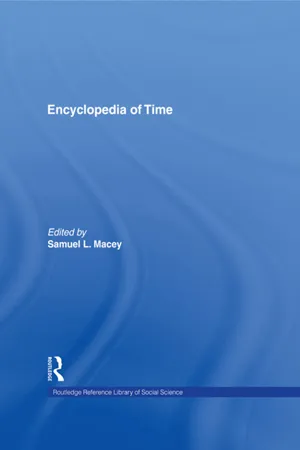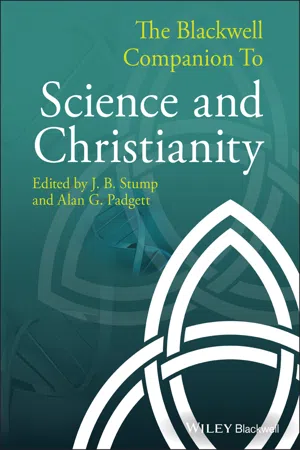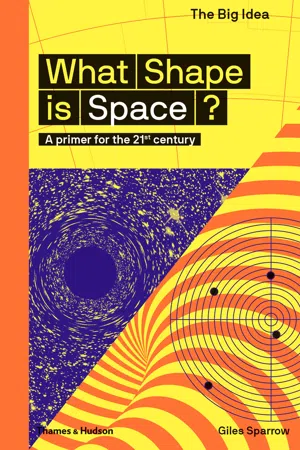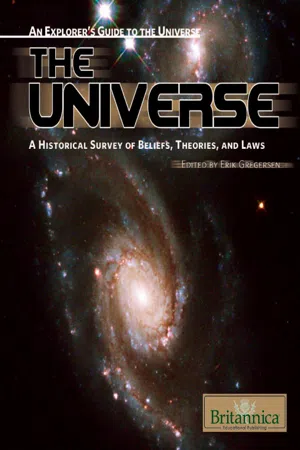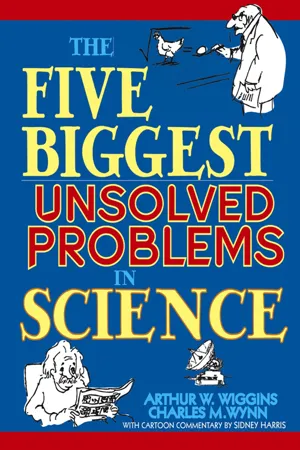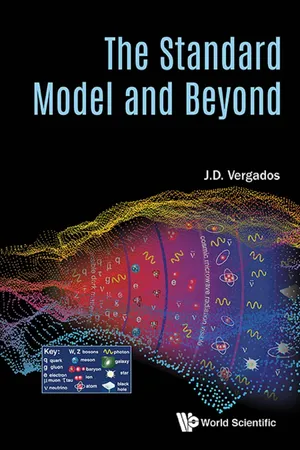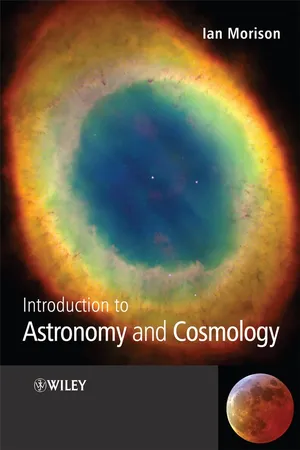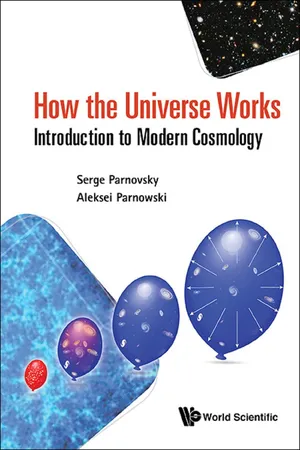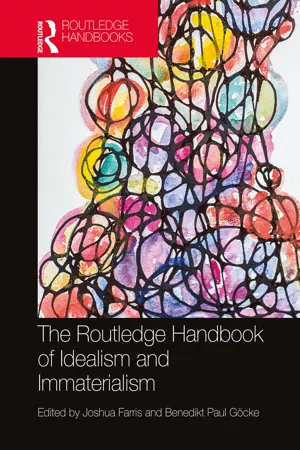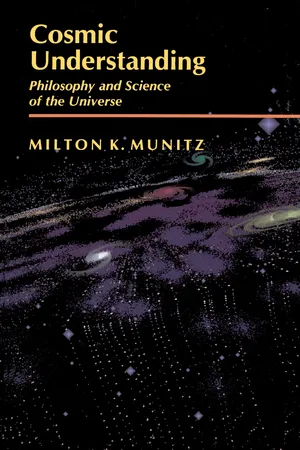Physics
Expanding Universe
The expanding universe refers to the observation that the space between galaxies is increasing over time. This phenomenon is supported by the redshift of light from distant galaxies, indicating that they are moving away from us. The concept is a key component of the Big Bang theory, which suggests that the universe began as a hot, dense point and has been expanding ever since.
Written by Perlego with AI-assistance
Related key terms
Related key terms
1 of 4
Related key terms
1 of 3
11 Key excerpts on "Expanding Universe"
- eBook - ePub
- Samuel L. Macey(Author)
- 2013(Publication Date)
- Routledge(Publisher)
Edwin Hubble assembled the evidence for an Expanding Universe in 1929. The theory of an Expanding Universe, pioneered by Alexander Friedmann in 1922 and Georges Lemaitre in 1927, was little known at the time. Various models of an Expanding Universe were proposed in the 1930s; most models were uniform in space, either infinite or finite in extent, in which all places evolved in synchronism and cosmic time measured the age of the universe. This general pattern forms the basis of modern cosmology.The expanding space paradigm (receding galaxies are at rest in expanding space) helps us to understand several aspects of modern cosmology. The light received from distant galaxies is red shifted (shifted toward the red end of the spectrum), and the farther away a galaxy, the greater its red shift and its velocity of recession. Light traveling in expanding space between the galaxies has its waves steadily stretched by the expansion of space. At the Hubble distance, the galaxies are receding from us at the velocity of light. The Hubble distance is estimated to be between 10 and 20 billion light-years (a light-year equals the distance light travels in one year, and nearby stars are roughly five light-years away). The expansion of space causes the galaxies beyond the Hubble distance to recede faster than the velocity of light. The expansion of space is governed by general relativity, and the velocity of expansion is not limited by the velocity of light.The Hubble time of 10 to 20 billion years serves as an approximate measure of the age of the universe. A more precise determination of the age depends on the way in which the expansion occurs. When Hubble first measured the rate of expansion, he obtained a Hubble time that was little more than 1 billion years, considerably less than the age of the earth. Cosmolo-gists in the 1930s and 1940s grappled with the perplexing cosmic age problem. Obviously, nothing in the universe can be older than the universe itself. Why then did the universe appear to be younger than the earth? Various solutions were proposed. Historically, the most interesting was the popular steady-state universe proposed by astronomers Hermann Bondi, Thomas Gold, and Fred Hoyle. In their expanding steady-state universe of infinite age, without beginning or end, matter was continuously created by an unknown mechanism at a rate that compensated for expansion. The created matter formed into new galaxies that occupied the widening gulfs between old galaxies, thus maintaining the same unchanging cosmic scenery. - J. B. Stump, Alan G. Padgett, J. B. Stump, Alan G. Padgett(Authors)
- 2012(Publication Date)
- Wiley-Blackwell(Publisher)
Cosmology studies the universe on the largest scales, and over large scales the most important force of nature is gravity. Our modern understanding of gravity is the theory of general relativity, proposed by Einstein in 1915. The key insight in this theory is the idea that space and time can be curved and have a dynamical life of their own, changing in response to matter and energy. As early as 1917, Einstein applied his new theory to cosmology, taking as an assumption something we still believe is true: that on the largest scales, matter in the universe (or at least our observable part of it) is uniform through space. He also assumed, consistent with the apparent implication of observations at the time, that the universe is static. To his surprise, Einstein found that general relativity implied that any uniform universe would necessarily be non-static – either expanding or contracting. In response he suggested modifying his theory by adding a new parameter called the “cosmological constant,” which acted to push against the tendency of matter to contract together. With that modification, Einstein was able to find a static (but unstable) solution if the cosmological constant were chosen precisely to balance against the attraction of matter on large scales.This discussion became somewhat academic when Edwin Hubble and Milton Humason announced in 1929 that the universe is expanding: distant galaxies are receding from us at speeds that are proportional to their distance. If the universe is expanding now, it was smaller in the past. (More properly, galaxies were closer together and the universe was more dense; it’s possible that space is actually infinite in extent.) Using the rules provided by general relativity, and some assumptions about the types of matter and energy that pervade the universe, we can play the movie backwards in time to reconstruct the past history of our universe. Eventually, about 13.7 billion years ago, we reach a moment of infinite density and spacetime curvature. This singularity is known as the “Big Bang.” Note that the phrase “Big Bang model” refers to the entire history of the Expanding Universe that began in a hot, dense state, the broad outlines of which are established beyond reasonable doubt. In contrast, the “Big Bang” itself, the initial singularity, is really just a placeholder for our lack of complete understanding.- eBook - ePub
What Shape is Space?
A primer for the 21st century
- Giles Sparrow, Matthew Taylor(Authors)
- 2018(Publication Date)
- Thames and Hudson Ltd(Publisher)
2. The Expanding UniverseThe fact that our Universe is expanding completely changes the ground rules when it comes to addressing the shape of space.A Arp 274 appears to be a closely linked group of interacting galaxies, but in reality the central galaxy is moving away from Earth a great deal faster than the others, and is therefore much more distant.Because the concentration of matter and mass is becoming less dense over time, its ability to warp space around it is, in most models, also diminishing. So how do we know that the Universe really is expanding, and why is it happening?The first and most important piece of evidence for cosmic expansion was identified even before Edwin Hubble’s confirmation in 1925 of the existence of galaxies beyond our own. As early as 1912, Vesto Slipher began a survey of the sky’s mysterious ‘spiral nebulae’ from Flagstaff, Arizona.Vesto Slipher (1875–1969) This US astronomer pioneered the use of light spectra to measure the motions of galaxies, and to investigate the atmospheres and rotation of planets.Slipher analysed these distant objects using an optical device called a spectrograph, which splits the faint light gathered by the telescope onto slightly different paths depending on its wavelength or colour. The principle of splitting light in this way had been demonstrated in the 1660s by Isaac Newton , when he took a narrow beam of apparently white sunlight and passed it through a glass prism to create a rainbow-like spectrum - eBook - ePub
The Accelerating Universe
Infinite Expansion, the Cosmological Constant, and the Beauty of the Cosmos
- Mario Livio(Author)
- 2008(Publication Date)
- Trade Paper Press(Publisher)
3Expansion
Modern cosmology is the study of the origin and the evolution of the universe as a whole. It deals with such fundamental questions as: What is the origin of the presently observed expansion of the universe? What is the origin of matter? What were the seeds from which the structures that we observe in the universe today, such as galaxies, emerged? These are not easy questions. The mere fact that we believe that we are coming close to being able to answer these and similar questions can in itself be regarded as absolutely amazing, given the fact that only a hundred years ago many of the questions did not even exist!Since the laws of nature have the elements of beauty engraved in them, it should come as no surprise that aesthetic principles played a major role in the shaping of our thinking about the origin of the universe.I will start with a simple, apparently unrelated example, which will turn out to have an enormous significance.Imagine that you are standing in the middle of a forest, in which all the tree trunks have been painted white. If the forest is not very large, then probably in some directions you can catch a glimpse of what is outside the forest through the gaps between the trees, since your line of sight in those directions does not intersect any trunk. Imagine now, however, that the forest around you is made thicker and thicker, simply by adding trees around the initial forest’s periphery, to larger and larger distances. Clearly, at some point, it will appear to you that you are surrounded by an environment that is uniformly white, because in whichever direction you would look, your line of sight would intersect a tree trunk. As we shall soon see, this example is intimately related to some properties of the universe. - eBook - ePub
The Universe
A Historical Survey of Beliefs, Theories, and Laws
- Britannica Educational Publishing, Erik Gregersen(Authors)
- 2009(Publication Date)
- Britannica Educational Publishing(Publisher)
XPANDING STUDY OF THE UNIVERSEW hen the universe was viewed in the large in the early 20th century, a dramatic new feature, not present on small scales, emerged—namely, the cosmological expansion, as defined by the Hubble law. Hubble’s original value for the constant was 150 km (93 miles) per second per 1 million light-years. Modern estimates, using measurements of the cosmic microwave background (CMB), place the value at between 21.5 and 23.4 km (13.3 and 14.5 miles) per second per 1 million light-years. The reciprocal of Hubble’s constant lies between 13 billion and 14 billion years, and this cosmic timescale serves as an approximate measure of the age of the universe.THE NATURE OF SPACE AND TIME
To speak of the expansion of space and time raises the question of what are space and time? What are their properties? Are they finite or infinite?An issue that arises when one contemplates the universe at large is whether space and time are infinite or finite. After many centuries of thought by some of the best minds, humanity has still not arrived at conclusive answers to these questions. Aristotle’s answer was that the material universe must be spatially finite, for if stars extended to infinity, they could not perform a complete rotation around Earth in 24 hours. Space must then itself also be finite because it is merely a receptacle for material bodies. On the other hand, the heavens must be temporally infinite, without beginning or end, since they are imperishable and cannot be created or destroyed.Except for the infinity of time, these views came to be accepted religious teachings in Europe before the period of modern science. The most notable person to publicly express doubts about restricted space was the Italian philosopher-mathematician Giordano Bruno, who asked the obvious question that, if there is a boundary or edge to space, what is on the other side? For his advocacy of an infinity of suns and earths, he was burned at the stake in 1600. - eBook - ePub
- Arthur W. Wiggins, Charles M. Wynn(Authors)
- 2008(Publication Date)
- Trade Paper Press(Publisher)
CHAPTER SIXASTRONOMY
Why Is the Universe Expanding Faster and Faster?
This is the exploration that awaits you! Not mapping stars and studying nebulae, but charting the unknown possibilities of existence.—Q to Captain Picard, Star TrekAstronomy or, more precisely, cosmology studies the origin, evolution, and large-scale structure and dynamics of the universe. Until recently, astronomy/cosmology’s biggest unsolved problem was a dynamic one, determining whether the universe will expand forever or eventually contract. The discovery of the universe’s increasing rate of expansion, which indicates that the universe will expand forever, may have solved that problem but created another one. The cause of this increased expansion, something called dark energy, seems to run counter to the current understanding of the forces that determine the dynamics of the universe. Finding an explanation for dark energy has become astronomy’s biggest unsolved problem.Contents of the Universe
“What’s out there?” is the classic question people ask when they look into the sky. Astronomy’s attempts to answer this question for the whole universe have tantalized us with fascinating answers and frustrated us with fascinating questions.The overall contents of the universe can be summarized in terms of its mass/energy. (Mass and energy were recognized as interconvertible through Albert Einstein’s famous equation relating them: Energy = (mass)(speed of light)2 , or E = mc 2 ). The following table presents the latest estimates for the mass/energy contents of the entire universe, along with brief comments regarding what we know about each.Universe Constituent % of the Universe’s Mass/Energy Comments Dark energy 73 Causes faster and faster expansion of the universe. Although unseen and of an unknown nature, the powerful effects of dark energy have been noted. - eBook - ePub
- J D Vergados(Author)
- 2017(Publication Date)
- WSPC(Publisher)
Fig. 10.1 . And yet we accept this principle, crucial as it is in understanding the evolution of the universe, and expect it to hold, if we will be able to see even further.Fig. 10.1: Even at the scale of 1000 Mpc, approximately 2 × 109 light years the universe is not completely homogeneous and isotropic as seen by the 2df Galaxy Redshift Survey of the galaxy cluster Coma. One still sees regions of high density and voids extending up 50 Mpc or 160 × 106 light years, which are among the largest seen in the universe (a). A view of what we expect a homogeneous and isotropic universe to be is shown in (b).10.2The Expanding Universe; the Big Bang scenario
From various observations it is clear that the our universe was born out of a huge explosion, Big Bang, which took place about 14 billion years ago. This is not like the explosions we see in everyday life, in which things are moving away from some center. In the ig bang scenario there is no such center. As we will see this simply means that the distance between any two objects, which are not gravitationally bound, increases by a time dependent scale factor. For a finite system this can be described by the blowing up of a balloon. General theory of relativity, which, at present, provides the best framework for the study of the evolution of the universe, accepts solutions which do not have a meaning for t ≤ 0.After the Big Bang the universe started expanding uniformly with a rate which depends on time. This is supported mainly by the following observations: (1)The receding of the galaxies. (2)The existence of the background microwave radiation.(3)The relic abundance of the 2 4 e in the universe.We will now examine each these observations.10.2.1The receding of galaxies
The receding of galaxies is perhaps the greatest discovery in cosmology. It is not clear when it was proposed for the first time and by whom. The prevailing view is that it was first conceived by Lemaitre in 1927 and it was formulated by Hubble in 1929, when he resolved Andromeda constellation into stars. He then discovered that in the Andromeda spirals there exist variable stars, which resemble the variable stars of our galaxy known Cepheids. This was indeed very important, since such stars can be used as prototype candles, in the sense that their absolute luminosity (power output) is known. This is because their exists a relationship between the absolute luminosity and their period. The absolute luminosity was calibrated from the Cepheids that exist in our galaxy, since their distance can be determined by the triangulation method. Thus, by measuring the relative luminosity (energy flux) in the laboratory one can determine the distance of these stars, which are much further away. He concluded that the Andromeda cloud was about 400000 light years away1 - eBook - ePub
- Ian Morison(Author)
- 2013(Publication Date)
- Wiley(Publisher)
Chapter 9Cosmology – the Origin and Evolution of the Universe
9.1 Einstein’s blunder?
Modern cosmology arose from Einstein’s General Theory of Relativity which, as we have seen, is essentially a theory of gravity (Figure 9.1 ). As gravity was the only force of infinite range that could act on neutral matter, Einstein realised that the universe as a whole must obey its laws. He was led to believe that the universe was ‘static’, or unchanging with time, and this caused him a real problem as gravity, being an attractive force, would naturally cause stationary objects in space to collapse down to one point. To overcome this he had to introduce a term into his equations that he called the cosmological constant, lambda or Λ. This represents a form of antigravity that has the interesting property that its effects become greater with distance. So, with one force decreasing and the second increasing with distance it was possible to produce a static solution. He later realised that this was an unstable situation, and that a static universe was not possible, calling this ‘the greatest blunder’ of his life. He could have predicted that the universe must be either expanding or contracting. However, as we shall see, perhaps he was not as wrong as he thought.9.2 Big Bang models of the universe
A Russian meteorologist, A.A. Friedmann, solved Einstein’s equations to produce a set of models in which the universe expanded from a point, or singularity. These were given the name Big Bang models by Fred Hoyle – this was meant to be a disparaging term as Hoyle was an advocate of another theory, the Steady State theory, to be discussed below, and did not like them! In all of these models, the initially fast rate of expansion is slowed by the attractive gravitational force between the matter of the universe. If the density of matter within the universe exceeded a critical amount, it would be sufficient to cause the expansion to cease and then the universe would collapse down to a ‘Big Crunch’ (these are called ‘closed’ universes). If the actual density was less than the critical density, the universe would expand for ever (called ‘open’ universes). In the critical case that is the boundary between the open and closed universes, the rate of expansion would fall to zero after infinite time (called the ‘flat’ or ‘critical’ universe) (Figure 9.2 - eBook - ePub
How the Universe Works
Introduction to Modern Cosmology
- Serge Parnovsky, Aleksei Parnowski(Authors)
- 2017(Publication Date)
- WSPC(Publisher)
Determination of the deceleration parameter of the real Universe, using data on the supernova explosions, gave an unexpected result. This value appeared to be negative. This means that our Universe is now expanding with acceleration. This discovery has brought its authors Saul Perlmutter, Brian Schmidt and Adam Riess the Nobel Prize in Physics in 2011 “for the discovery of the accelerating expansion of the Universe through observations of distant supernovae”. To explain this effect, it is necessary to introduce a new entity resembling a cosmological constant or dark energy.2.7Non-Relativistic Friedmann Solutions*
In this Section we obtain the mathematical description of the three Friedmann models using classical Newtonian law of universal gravitation and calculate the deceleration parameter.2.7.1Cosmological evolution without cosmological constant*
Let us first consider the simplest model, when the Universe is uniformly filled with some dust-like matter, i.e. matter without pressure, with density ρ(t) depending on time. We choose an arbitrary point, which will be temporarily considered as the centre of the Universe. Naturally we can take any other point and assign it as the centre of the Universe: the equations will be the same due to the homogeneity of the Universe.Consider a sphere of radius r(t) around this centre attached to the matter and expanding together with it according to the Hubble’s law. Every atom, every particle of matter can not cross this sphere. Whatever was inside the sphere remains inside permanently, whatever was outside remains outside, and whatever was on the surface remains on the surface. The radius of the sphere is small compared to the value c/H, so its motion is non-relativistic and we can use the simple form (2.1) of the Hubble’s law υ(t) = H(t)r(t), where υ(t) = dr(t)/dt is the expansion rate of the sphere with radius r(t). Thus, H(t) = dr(t)/dt r−1 (t).The volume of the sphere is equal to 4πr3 /3 and the mass of the dustlike matter inside is equal to M = 4πρr3 /3. This mass remains the same during the expansion, so, introducing a constant value B = 3M/4π - Joshua Farris, Benedikt Paul Göcke, Joshua Farris, Benedikt Paul Göcke(Authors)
- 2021(Publication Date)
- Routledge(Publisher)
PART 4 Idealism and sciencePassage contains an image
37 Mind before matter
The unexpected implications of quantum cosmology
Stephen C. MeyerDOI: 10.4324/9781003202851-421. Introduction
During the twentieth century, observational astronomy and theoretical physics converged on a startling conclusion: the universe had a beginning. During the 1910s and 1920s, astronomers determined, based on their analysis of the light from distant galaxies, that the galaxies beyond our Milky Way were receding from us in all directions of the night sky. From this discovery, they deduced that the universe is expanding outward in a roughly spherically symmetric manner from a point in the finite past – one marking the beginning of the expansion and, arguably, the beginning of space, time, and the universe itself (Hubble, 1929: pp. 168–173). During the rest of the twentieth century, many other observations, such as the detection of the cosmic background radiation and its specific properties, supported the new ‘big bang’ cosmology. These observations rendered increasingly untenable competing cosmological hypotheses such as the steady-state and oscillating universe models that denied a beginning.Developments in theoretical physics also provided support for the idea of a temporal beginning. During the late 1960s, Stephen Hawking, Roger Penrose, and George Ellis1 solved the field equations of general relativity – Albert Einstein’s theory of gravity that describes how matter curves space (or spacetime).2 Their solutions implied a universe that had begun from a ‘space-time’ singularity of ‘infinite curvature’ (Hawking & Ellis, 1973: pp. 261–262). Indeed, the theory of general relativity implied, as Hawking and Ellis wrote, ‘that there is a singularity in the past that constitutes, in some sense, a beginning of the universe’ (Hawking & Ellis, 1973: p. xi).This striking insight originated with Stephen Hawking while he was working on a PhD in physics at Cambridge University in the early 1960s. Hawking began to think about how the density and volume of the Expanding Universe would have changed over time, given the evidence of an Expanding Universe. He realized that at every point in the past, the mass of the universe would have been more densely concentrated. That meant, according to Einstein’s theory of gravity, that space would have been more tightly curved at every successive point farther and farther back in time. In his mind’s eye, as he extrapolated backwards in time, he saw that at some point, the curvature of the universe would reach a limit – that is, it would attain an infinitely tight spatial curvature corresponding to zero spatial volume.- eBook - ePub
Cosmic Understanding
Philosophy and Science of the Universe
- Milton K. Munitz(Author)
- 2021(Publication Date)
- Princeton University Press(Publisher)
Particle physicists refer to the different stages at which forces become differentiated from one another through spontaneous symmetry-breaking as examples of “freezing.” There are, accordingly, several distinct levels or types of freezings. At the highest energy level, all four forces would be unified: there would be but one force, and a total or perfect symmetry of all forces would prevail. It is this condition that supersymmetry theories would describe. When this symmetry is broken, due to a drop in energy and temperature, the differentiation of forces described by grand unification theories takes place. At this stage, there are two main forces instead of one: on the one hand, the gravitational force, and on the other, the single force that combines the electroweak and strong forces. With a further drop in energy and temperature, the next freezing takes place in which three forces are present—namely, the electroweak, strong, and gravitational. Finally, at still lower energies and temperatures, the symmetry of the electroweak force is itself broken, and the familiar distinctions among the four forces emerge.These investigations have the most profound bearing upon cosmology. The picture of successive freezings represent distinct plateaus of differentiation among forces at major stages in the evolution of the universe. The crucial facts that link theories of particle physics and cosmology are those connected with the successive drops in energy and temperature due to the expansion of the universe. Each major freezing represents a transition to a new physical level in which distinct forces (and the particles they involve) emerge from a relatively undifferentiated unity or matrix.In recent physics, much progress has been made in understanding the physical processes at work not only in the early universe but also in the very early universe.11 Until recently, the standard hot big bang model of the Expanding Universe dominated cosmological thinking. It claimed that the universe began in a state of infinite density and temperature and subsequently expanded in a spatially uniform way. In support of this model, the direct observational evidence consisted of the microwave background radiation. Such evidence, however, reaches back not to the very beginning, as this is conceived by the theory, but only to the stage (several hundred thousand years after the big bang) at which matter decoupled from radiation and liberated that radiation. Further empirical evidence in support of the hot big bang model is of an indirect sort and consists in a broad agreement between the predictions of the theory and the actually observed relative abundances of light elements— for example, hydrogen, helium, deuterium, and lithium. The standard hot big bang model thus has much to contribute in helping to understand events on a cosmological scale in the “early universe,” where the latter expression is used to designate occurrences that took place after
Index pages curate the most relevant extracts from our library of academic textbooks. They’ve been created using an in-house natural language model (NLM), each adding context and meaning to key research topics.
Explore more topic indexes
Explore more topic indexes
1 of 6
Explore more topic indexes
1 of 4
